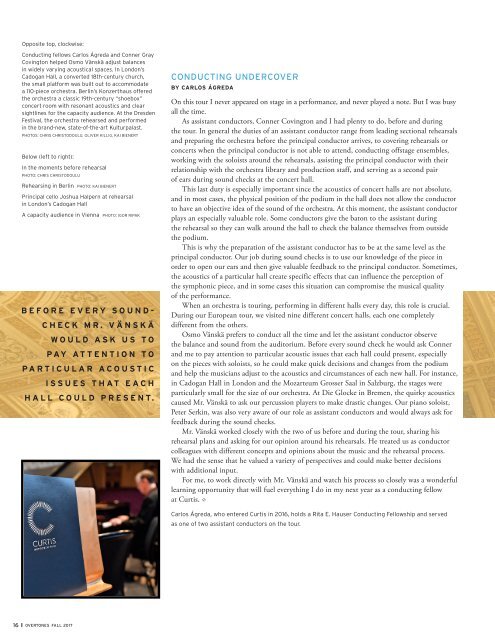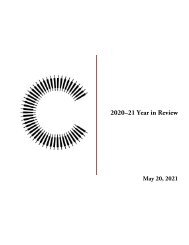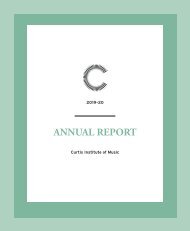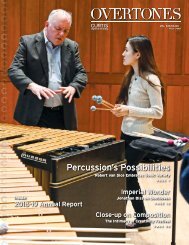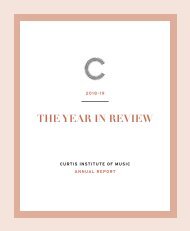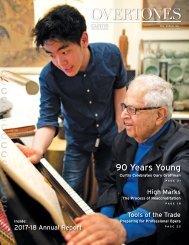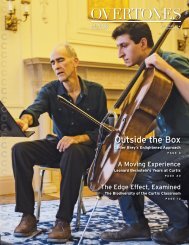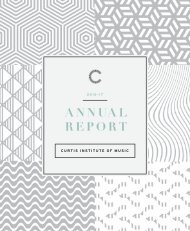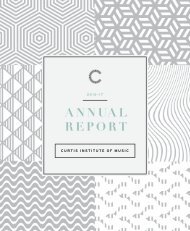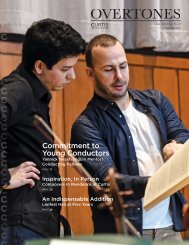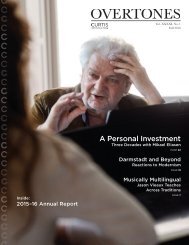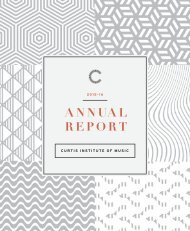Curtis Overtones Fall 2017_BluelineChanges_2
Create successful ePaper yourself
Turn your PDF publications into a flip-book with our unique Google optimized e-Paper software.
Opposite top, clockwise:<br />
Conducting fellows Carlos Ágreda and Conner Gray<br />
Covington helped Osmo Vänskä adjust balances<br />
in widely varying acoustical spaces. In London’s<br />
Cadogan Hall, a converted 18th-century church,<br />
the small platform was built out to accommodate<br />
a 110-piece orchestra. Berlin’s Konzerthaus offered<br />
the orchestra a classic 19th-century “shoebox”<br />
concert room with resonant acoustics and clear<br />
sightlines for the capacity audience. At the Dresden<br />
Festival, the orchestra rehearsed and performed<br />
in the brand-new, state-of-the-art Kulturpalast.<br />
PHOTOS: CHRIS CHRISTODOULU, OLIVER KILLIG, KAI BIENERT<br />
Below (left to right):<br />
In the moments before rehearsal<br />
PHOTO: CHRIS CHRISTODOULU<br />
Rehearsing in Berlin PHOTO: KAI BIENERT<br />
Principal cello Joshua Halpern at rehearsal<br />
in London’s Cadogan Hall<br />
A capacity audience in Vienna PHOTO: IGOR RIPAK<br />
B E F O R E E V E R Y S O U N D -<br />
C H E C K M R . V Ä N S K Ä<br />
W O U L D A S K U S T O<br />
P AY A T T E N T I O N T O<br />
P A R T I C U L A R A C O U S T I C<br />
I S S U E S T H A T E A C H<br />
H A L L C O U L D P R E S E N T.<br />
CONDUCTING UNDERCOVER<br />
BY CARLOS ÁGREDA<br />
On this tour I never appeared on stage in a performance, and never played a note. But I was busy<br />
all the time.<br />
As assistant conductors, Conner Covington and I had plenty to do, before and during<br />
the tour. In general the duties of an assistant conductor range from leading sectional rehearsals<br />
and preparing the orchestra before the principal conductor arrives, to covering rehearsals or<br />
concerts when the principal conductor is not able to attend, conducting offstage ensembles,<br />
working with the soloists around the rehearsals, assisting the principal conductor with their<br />
relationship with the orchestra library and production staff, and serving as a second pair<br />
of ears during sound checks at the concert hall.<br />
This last duty is especially important since the acoustics of concert halls are not absolute,<br />
and in most cases, the physical position of the podium in the hall does not allow the conductor<br />
to have an objective idea of the sound of the orchestra. At this moment, the assistant conductor<br />
plays an especially valuable role. Some conductors give the baton to the assistant during<br />
the rehearsal so they can walk around the hall to check the balance themselves from outside<br />
the podium.<br />
This is why the preparation of the assistant conductor has to be at the same level as the<br />
principal conductor. Our job during sound checks is to use our knowledge of the piece in<br />
order to open our ears and then give valuable feedback to the principal conductor. Sometimes,<br />
the acoustics of a particular hall create specific effects that can influence the perception of<br />
the symphonic piece, and in some cases this situation can compromise the musical quality<br />
of the performance.<br />
When an orchestra is touring, performing in different halls every day, this role is crucial.<br />
During our European tour, we visited nine different concert halls, each one completely<br />
different from the others.<br />
Osmo Vänskä prefers to conduct all the time and let the assistant conductor observe<br />
the balance and sound from the auditorium. Before every sound check he would ask Conner<br />
and me to pay attention to particular acoustic issues that each hall could present, especially<br />
on the pieces with soloists, so he could make quick decisions and changes from the podium<br />
and help the musicians adjust to the acoustics and circumstances of each new hall. For instance,<br />
in Cadogan Hall in London and the Mozarteum Grosser Saal in Salzburg, the stages were<br />
particularly small for the size of our orchestra. At Die Glocke in Bremen, the quirky acoustics<br />
caused Mr. Vänskä to ask our percussion players to make drastic changes. Our piano soloist,<br />
Peter Serkin, was also very aware of our role as assistant conductors and would always ask for<br />
feedback during the sound checks.<br />
Mr. Vänskä worked closely with the two of us before and during the tour, sharing his<br />
rehearsal plans and asking for our opinion around his rehearsals. He treated us as conductor<br />
colleagues with different concepts and opinions about the music and the rehearsal process.<br />
We had the sense that he valued a variety of perspectives and could make better decisions<br />
with additional input.<br />
For me, to work directly with Mr. Vänskä and watch his process so closely was a wonderful<br />
learning opportunity that will fuel everything I do in my next year as a conducting fellow<br />
at <strong>Curtis</strong>. <br />
Carlos Ágreda, who entered <strong>Curtis</strong> in 2016, holds a Rita E. Hauser Conducting Fellowship and served<br />
as one of two assistant conductors on the tour.<br />
16 OVERTONES FALL <strong>2017</strong>


